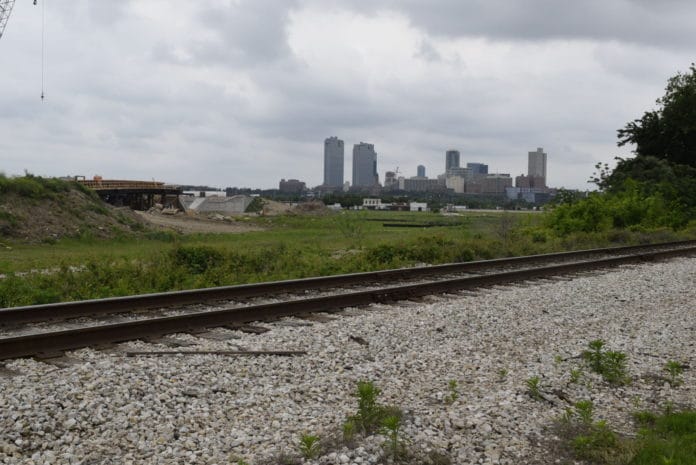Mayor Betsy Price pledged her support to angry and frustrated business owners along White Settlement Road as a new imbroglio with the Trinity River Vision bridges is threatening additional costs and delays.
Price walked into the April 24 meeting of the newly formed White Settlement Road Development Task Force after she and city administrators met with a representative for the contractor building the three bridges that will eventually connect with the anticipated Panther Island, she said.
Without disclosing details, Price characterized that latest trouble as a “dispute between the contractor and TxDOT (Texas Department of Transportation).”
“We’re as frustrated as you are,” Price said to members of the business group. “Right now we don’t think we have the right people at the table.
“But we’re going to get the appropriate people to help,” she said. “Right now there’s a lot of finger-pointing going on.”
The three bridges are the most publicly visible sign of progress on the complex $1.17 billion Panther Island project, also known as the Central City project.
Like the entire project, the bridges have been mired in controversy and setbacks. Construction of the bridges began in 2014 with anticipated completion dates staggered between 2017 and 2018.
In the latest update from TxDOT, the bridges are scheduled to be complete on a staggered schedule between late 2020 and 2021. But even those dates are in flux.
Development of the entire project is being done through a partnership that includes the city of Fort Worth, Tarrant County, the Army Corps of Engineers, the Tarrant Regional Water District and its subsidiary the Trinity River Vision Authority.
The TRVA manages the project. The bridges were designed by Freese and Nichols and Miguel Rosales of Boston.
The approximately $65 million bridge construction is responsibility of TxDOT and the city because Henderson Street and North Main Street are part of the state highway system and White Settlement is a city street.
The bridges are fully funded, not including any cost overruns, officials say.
Construction and detours have become an inconvenience and source of frustration for drivers and businesses owners since bridge construction first began but nowhere has it been as problematic as it is on White Settlement, where deep-rooted family-owned businesses struggle to survive.
“Some of us have seen business down 45 percent,” said Steve Metcalf, a master auto mechanic who owns the Dealer Alternative service shop on White Settlement and serves as chair of the White Settlement Road Development Task Force.
“A few companies have gone out of business or gone away,” Metcalf said. “A lot of us are struggling to hold on.”
The biggest obstacle for these businesses is that White Settlement has been cut off from Henderson, which provided a convenient link to downtown Fort Worth. Now, the only way for traffic to access the businesses is through a round-about route along the increasingly-traffic-snarled West 7th Street.
Restaurants on White Settlement such as Angelo’s Barbecue, a 60-year stalwart, have suffered since downtown workers don’t have enough time to battle traffic and eat within an hour.
“The numbers are down, customers are down, we’ve had to cut back on staff and employees,” said Jason George, owner of Angelo’s. “Just because of the lack of business.”
For a while, business owners had posted a sign near the construction site, counting down the days until the bridge was finished and White Settlement could re-open to thru-traffic.
But when the 2017 completion date passed with no end in sight, the sign came down.
As construction dragged on, some of the business owners contemplated legal action to get relief, said Gerry Goodman, owner of European Motor Cars Ltd. on White Settlement.
“We talked to three different lawyers who we thought might take it on pro-bono,” Goodman said. “One said $10,000 would be a good deal but he would do it for $5,000.”
But with businesses struggling to hang on, even that much was a stretch, Goodman said. “We just dropped it.”
Business owners have had strong support from District 7 City Councilman Dennis Shingleton, who is sympathetic with the struggles of the White Settlement Road businesses that don’t have the benefits of “work-arounds” that businesses on Henderson and North Main do.
“What was supposed to be a 2.5-year project is now in its fifth year,” Shingleton remarked the business owners at the task force meeting. “These businesses need relief.”
Scott Cooner, a TxDOT representative, updated progress on the bridges and noted that White Settlement is the furthest along and would be the first to finish. Cooner said pouring the V-Pier support structures are moving along at about one per week.
All eight V piers of the White Settlement are complete, he said.
But what that did to buoy hopes for the business owners was overshadowed by Cooner’s inability to give a firm completion date and that the contractor has 50 employees onsite working on all three bridges simultaneously.
“Our goal is to get done as quickly as quickly as possible,” Cooner said. “Our schedule is dynamic because this a very complex (project) and we need to build it the right way.”
The business owners quickly realized that 50 employees meant an average of 15 per bridge. “Why not 150?” one owner asked.
The number of employees on-site and prolonged period of construction are apparently tied to unresolved issues involving the contractor, TxDOT and some or all of the partners in Panther Island project.
Arlington-based attorney Frank Hill, who is representing the contractor, said he was the person who met with Price and other city officials before the task force meeting.
He acknowledged that the contractor is seeking compensation for delays that are beyond the contractor’s control.
“The contractor is very late because the design is fundamentally flawed,” Hill said.
Hill said the contractor can only afford to keep 50 employees onsite as delaying design changes are a “continuing occurrence.”
The contractor is Sterling Construction Co., a Houston-based public company that reported annual revenues of $1 billion in 2018. The company is a veteran TxDOT contractor.
Doug Rademaker, senior capital projects officer for the city, told the Fort Worth Business Press recently that the contractor has a pending claim for an additional 221 days of work.
City Manager David Cooke said TxDOT typically settles its contractor claims for cost overruns at the end of a project.
This is not the first acknowledgement that bridge design has impeded progress. In March 2016, TxDOT officials reported a “malfunction of design” with the V piers that would result in a temporary delay but workers would continue work in other areas.
But it wasn’t until June 2017 that those issues were announced by TRVA officials to the TRVA board, according to Fort Worth Business Press archives.
The bridge design has long been a source of contention.
Emails posted on the online by the Texas Monitor, a digital government watchdog publication, point to TRVA executive director J.D. Granger’s 2012 argument in favor of the V-pier bridge design because they had already been vetted and approved by the Army Corps of Engineers.
The matter came up because TxDOT had offered to cover the cost of the bridges if the TRVA chose the West Seventh Street bridge design instead.
The Corps has green-lighted the project to receive $526 million in federal funds to dig a 1.5-mile bypass channel on the Trinity River north of the Tarrant County Courthouse. That channel would add flood control protection as well as carve out an 800-acre center island, which would create waterfront economic development opportunities. The bridges will cross the channel.
The project has been appropriated about $60 million so far but has failed to receive any funds in the past three Congressional funding cycles and was not included on the Trump administration’s 2020 list of Corps priorities.
– Additional reporting by Neetish Basnet









